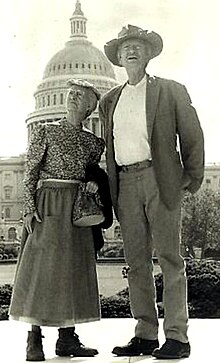Rural purge
CBS saw a dramatic change in direction with the shift, moving away from shows with rural themes and toward more appeal to urban and suburban audiences.
[2] Programming in American television during the late 1940s and early 1950s was "as culturally diverse ... as [had] ever existed", according to the media historian Sara K. Eskridge.
They also were widely enjoyed by the rapidly expanding viewership in rural areas and the American South; urban-themed programming, as a result, diminished in general favor.
[15] ABC, which typically ranked third in ratings, was motivated to experiment with its programming;[14] it sought to create a rural-themed sitcom that would be acceptable to families.
Ekskridge observed that with its popular reception, CBS "not only took the lead in creating pure rural comedy, it also perfected the art of marketing such series":[20] In rural comedy, [CBS] discovered a form of programming that provided pure escapism, that neither cast aspersions upon the network's patriotism, nor subjected it to scandal, yet still appealed to large numbers of people.
Its creator, Paul Henning, utilized his childhood experiences in Missouri to explore the social dynamics between urban and rural dwellers.
"[29] As summarized for the Museum of Broadcast Communications: By the late 1960s, … many viewers, especially young ones, were rejecting [rural-themed] shows as irrelevant to modern times.
Mayberry's total isolation from contemporary problems was part of its appeal, but more than a decade of media coverage of the civil rights movement had brought about a change in the popular image of the small Southern town.
CBS executives, afraid of losing the lucrative youth demographic, purged their schedule of hit shows that were drawing huge but older-skewing audiences.The 1970 cuts were preceded in 1967, for similar reasons of viewer demographics, when CBS ordered cancellation of its remaining game shows, Password, What's My Line?, I've Got a Secret, and To Tell the Truth; the last continued in daytime for another year.
[30] The network attempted to incorporate more urban programming, including the innovative sitcom He & She in the 1967 season, but a clash with that show's lead-in (Green Acres) led to its cancellation.
Lassie and Hee Haw almost immediately went into first-run syndication, where stations (many of them CBS affiliates) usually aired the shows in the fringe time slot that the networks had been forced to surrender.
For the time slots that the networks retained, CBS head Fred Silverman replaced much of the canceled programming in 1971 and 1972 with "relevant" fare.
[41] Most of the rural-oriented programs were filmed in the single-camera setup without a studio audience, with the canned laughter added by laugh-track proprietor Charley Douglass.
The newer shows that came to television in the early 1970s were multiple-camera setups with live studio audiences, a trend that would become the norm throughout the 1970s and even into today, with Douglass's laugh track mostly limited to sweetening.
This was not possible for M*A*S*H, which was filmed on location, but due to the occasionally serious nature of the material, producers of the military hospital dramedy did not want a laugh track to be used.
He would also, with less success, commission The Brady Bunch Hour for ABC in 1976 and Pink Lady and Jeff and The Susan Anton Show for NBC in 1980, all three of which were received poorly.
The backlash from the purge prompted CBS to commission a rural family drama, The Waltons, for its fall 1972 schedule based on the TV film The Homecoming: A Christmas Story (1971).
One media critic stated that only four of note had been made—House of Payne, Meet the Browns (both from Atlanta-based Tyler Perry), Designing Women and The Carmichael Show.
[46] Other examples include Evening Shade, a Burt Reynolds vehicle set in a fictionalized version of Evening Shade, Arkansas;[47] The Golden Girls, set in Miami, Florida, and featuring the identifiably Southern Blanche Devereaux and rural Rose Nylund as main characters;[48] Mama's Family, set in a Southernized version of Raytown, Missouri,[49] and featuring Mayberry RFD star Ken Berry in a major supporting role; and the animated sitcom King of the Hill, which ran for 13 seasons on the Fox network and featured a caricature of suburban Texas life.
[50] Non-rural-themed shows canceled by CBS included sitcoms Family Affair and Hogan's Heroes in 1971, with the long-running My Three Sons ending in 1972.
Martial artist Bruce Lee, in attempting to pitch his series The Warrior to television networks, stated he was told that "the Western idea is out.
"[51] However, by 1972, ABC produced a new Western series based on Lee's idea called Kung Fu, but cast white actor David Carradine in the lead.
